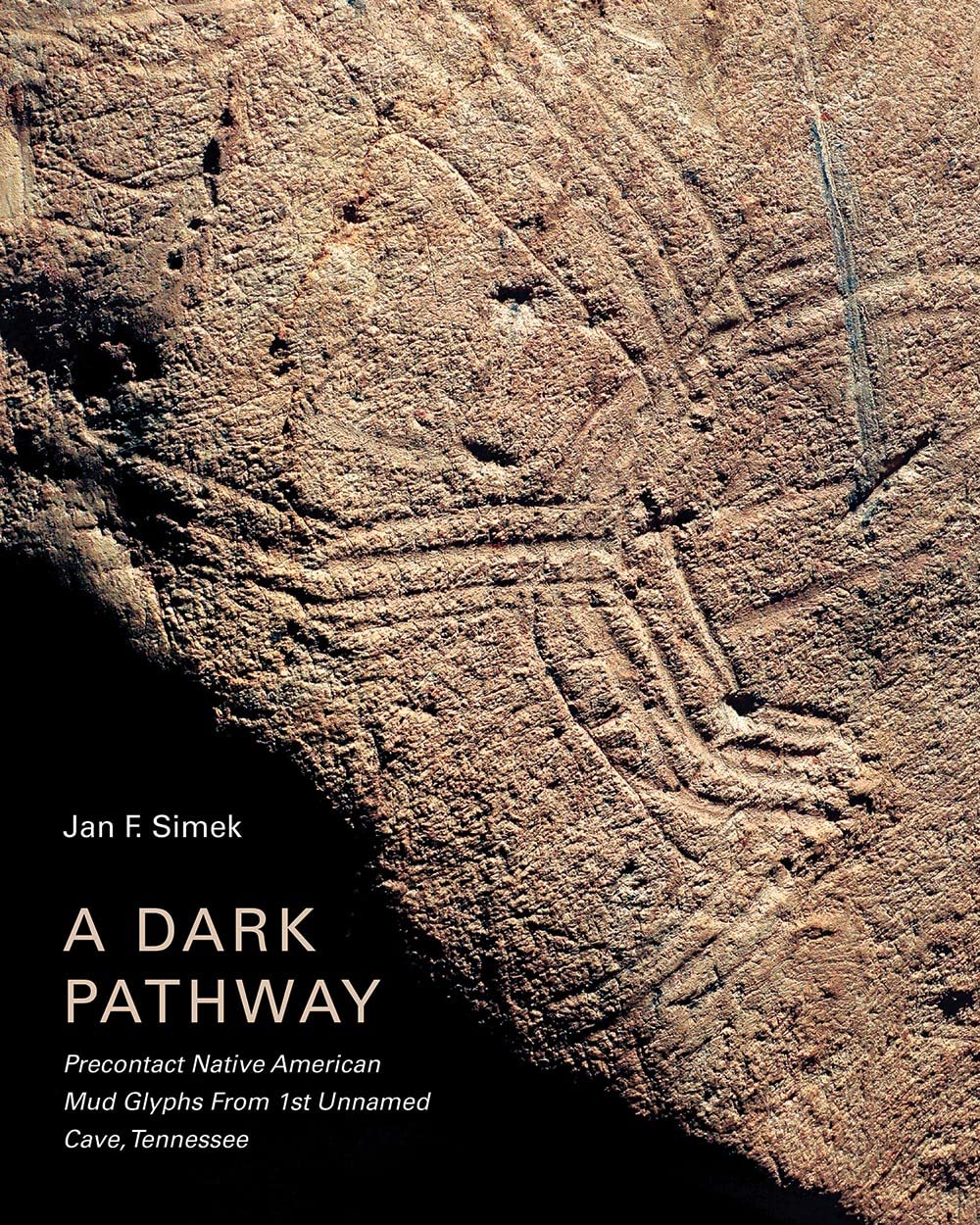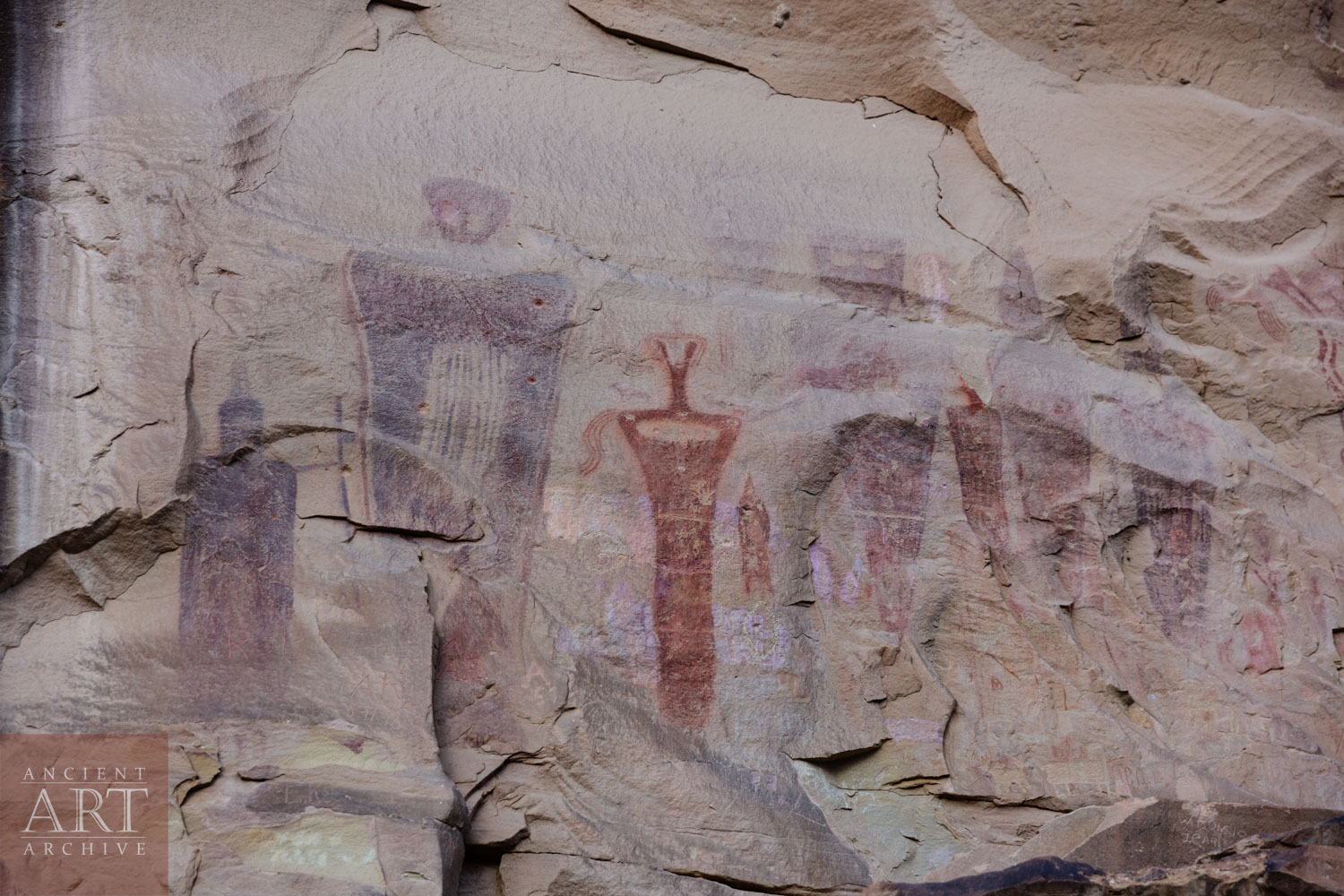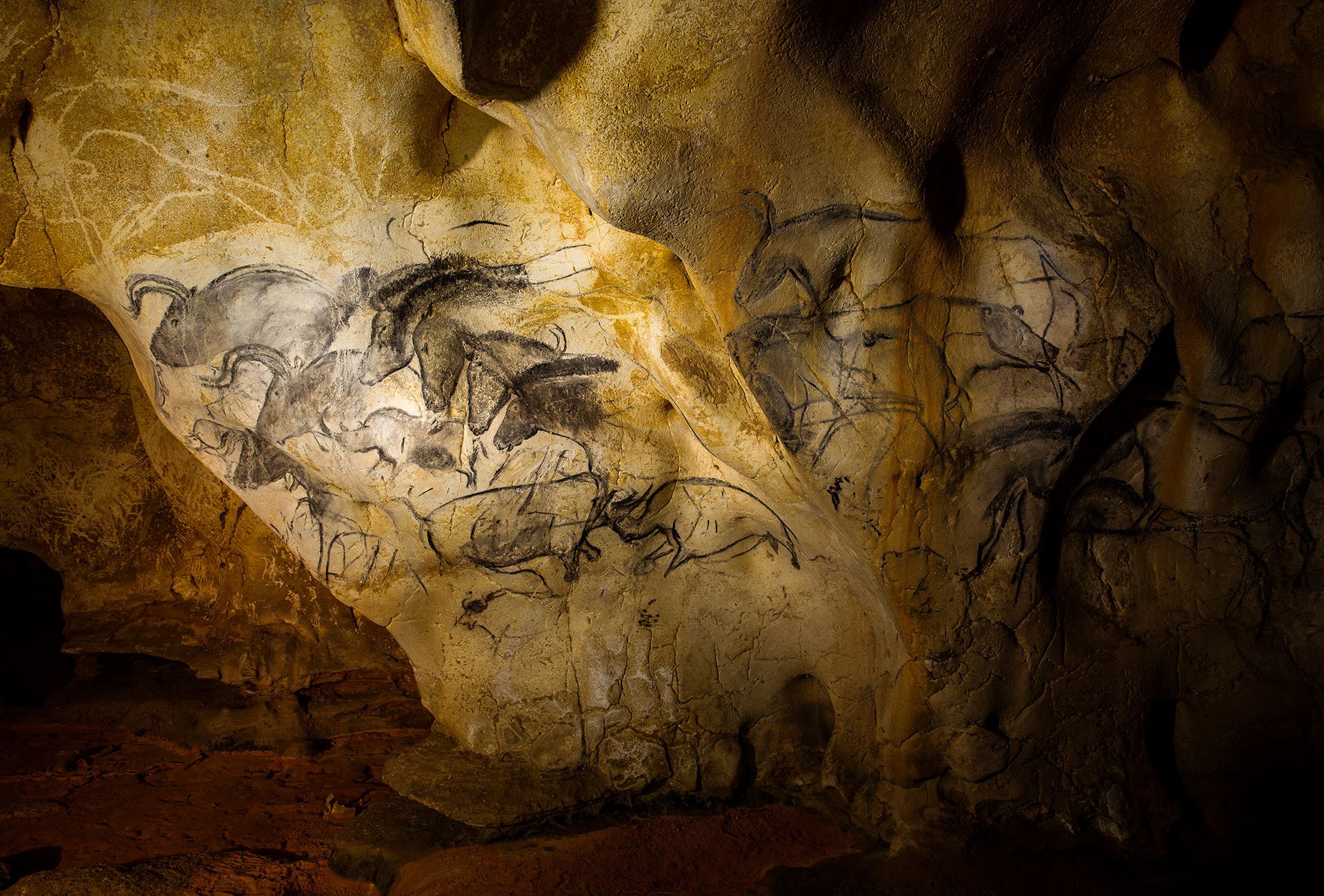Founding board member emeritus Dr Jan Simek has a new book about cave art in the Southeastern United States. Dr David Whitley gives us a detailed review.
A Dark Pathway: Precontact Native American Mud Glyphs from 1st Unnamed Cave, Tennessee, by Jan F. Simek. 2022. Knoxville: University of Tennessee Press. xviii+195 pp., 85 b&w and 19 color figures, 14 tables, bibliography, index. ISBN 9781621907176, hardcover.
Rock Art Research Institute
University of the Witwatersrand
“Mud glyph” and “1st Unnamed Cave” are not particularly inspiring terms that, at first glance, might promote reading this book. Yet these very earthy, workman-like words in the sub-title exactly belie the careful, compelling and in fact exciting study detailed in this volume. Anyone interested in the Native American symbolic and spiritual world will benefit from and enjoy this book; it should be required reading for those concerned with the indigenous southeastern US specifically.
Mud glyphs are designs or motifs that are finger-drawn on viscous clay surfaces that form naturally, due to chemical weathering processes, and that coat the walls and ceilings of some limestone caves. The glyphs are a form of rock art that, while found sporadically in specific environmental settings worldwide, only occurs in the southeast in the US (insofar as we currently know). And mud glyphs are typically found in the dark zone portions of these caverns: those areas where natural light never penetrates. The first North American example of this phenomenon was discovered in Tennessee by archaeologists in 1979 (see C.H. Faulkner, editor, 1986, The Prehistoric Art of Mud Glyph Cave, Knoxville: University of Tennessee Press); eighteen more have been subsequently found. 1st Unnamed Cave, discovered in 1994, is the first of a series of these cave sites that have been intentionally named ambiguously to prevent vandalism to these extremely fragile sites: even the accidental brush of a backpack through a careless move by an otherwise concerned visitor could unintentionally scrape-away a motif, to say nothing of the intentional looting and destruction of many sites that is endemic in the US.
Appropriately then, 1st Unnamed Cave is the first full documentation of one of these types of sites since Faulkner’s 1986 publication. It is a product of the University of Tennessee Cave Archaeological Research Team, a group led by book author Jan Simek following the discovery of this site. Work at 1st Unnamed Cave, between 1994 and 2008, involved excavations at the entrance, careful mapping of the motifs, and the photographic documentation of the art. (Though people occasionally camped at its mouth and visited the galleries inside, no one ever resided inside the cave). Sixty-nine motifs are present. All but one of these are finger-drawn into the clay; the exception is a “painting” made of wet mud. Radiocarbon dates and other materials from the excavations indicate primary cave use between AD 1420 and the historic period (post-1831) with most occurring in the 16th century. Evidence at other southeastern mud glyph caves however shows that this art tradition is quite ancient, potentially extending back about 7,000 years, though most sites date to the last 4,000 years. 1St Unnamed Cave can then be understood as a late Precontact (“Late Woodlands”) to historic period manifestation of a very long-lived cultural practice.
That the use of the cave occurred to at least 1831 indicates that this artistic tradition continued well after contact with Euro-Americans. This is important given that many archaeologists assume that the arrival of Europeans resulted in a catastrophic and near immediate collapse of all indigenous traditions and practices. One outcome of this assumption is a denial of the relevance of ethnographic texts—colonial and anthropological accounts of traditional indigenous lifeways collected in the post-contact period—to understanding the archaeological record, even in its latest manifestations. The 1st Unnamed Cave evidence demonstrates the falsity of that assumption, opening the door to an ethnographic interpretation of the art.
The chapters in this book follow the logic of Simek’s analysis, completed after the conclusion of the fieldwork. They include discussions of the cave’s geological setting and the fieldwork (including excavations), a catalog of the motifs, a description of their distribution in the cave, a comparison to other such caves in the southeast, and a synthesis and interpretation of the site and its art. The result is both a thorough documentation of this remarkable iconographic corpus and a thoughtful and penetrating consideration of what the site and the art likely meant to its creators and indigenous visitors.
The motifs present at 1st Unnamed Cave are predominantly simple geometric patterns: meanders, circles, barred-Xs, and ogees (sometimes called the “open eye” motif), among others. Two human figures are also present, one of which has wings indicating that it is a transformational figure: a conflation of human and animal, common in Native American religious imagery. An insect, likely a spider or water-strider, is also present and may be one of the keys to the site’s interpretation.
The analysis of the distribution of the motifs reflects Simek’s training in and experience working at western European Paleolithic (or Ice Age) sites, where he spent much of his earlier career and where such distributional rock art studies are more common than in the western hemisphere. One interesting outcome of this analysis is the recognition that the ogee motifs book-end the distribution of the glyphs, suggesting that the site reflects a coherent composition and thus was intended to be understood as such, rather than solely by reference to isolated or individual images.
The chronology for 1st Unnamed Cave sets up Simek’s detailed interpretation of the site, which is based on ethnography, especially James Mooney’s key 1900 publication (Myths of the Cherokee, Nineteenth Annual Report, Bureau of American Ethnology, Washington, DC: Government Printing Office). This helps link the cave to religious iconography and experiences, especially the conceptualization of a three-tiered cosmos with the cave representing the Lower World, a place of chaos and darkness, where various spirits resided. Simek then notes that:
“1st unnamed cave was…more than a set of mud pictures on a cave wall. It was a pathway through a cosmic realm materialized—made visible—by mud glyph drawings on the walls and ceilings” (pp. 122).
More than just graphic images, in other words, the motifs in the cave are the visual components of a ritual intended to result in an experiencing of the underworld. A supplicant entered and transited through the cave not just to “see” the art but instead to visit and thereby better understand the lower tier of the cosmos, in what today we would label an immersive religious experience.
The book concludes with an especially important observation. This involves mud (or, perhaps more accurately, clay). Mud is of course the most mundane of substances; one that often clings to our boots or stalls our cars but, in almost all circumstances, is to us a little more than an irritant. Looking beyond this everyday modern perception, Simek asks whether the mud covering the cave walls and ceilings itself had deep symbolic meaning to the indigenous peoples who made this art. He hints at this possibility at a few points in the book with reference to the motifs and their possible equivalence to those found on ceramics, likewise made of clay. He speculates that, since women are known to have been the indigenous potters, perhaps the cave art too was created by women. His concluding comment, however, relates the mud of the cave more broadly to the Cherokee creation myth. This recounts how an insect created the land—and thus the middle, human tier of the cosmos—by diving underwater in the primordial sea and bringing up mud, which quickly spread and created the island that is earth, occupied by humans. This is one example of an extremely widespread and ancient origin tradition, common throughout Native America and Eurasia, called the Earth-Diver myth (e.g., A. Dundes, 1962, Earth-Diver: Creation of a Mythopoeic Male. American Anthropologist 64:1032-1051). Simek observes that:
“The caves of the southeast provided real and tangible access to the Lower World, and it is not surprising that they would be venerated, decorated, and used to materialize an important aspect of the cosmos…The Lower World was an especially important place from the point of view of birth and rebirth, since it was there that the earth had its origin. [And it was an insect] that played a pivotal role in that creation” (pp. 161).
1st Unnamed Cave not only represented the Lower World in a tiered cosmos, then, but also the point of creation, with ritual use of the site tied to both circumstances. Yet as exciting as this interpretation may be, there is another aspect of this research that warrants mention. I judge the value of a scientific analysis not solely by the answers that it provides, though these are always very important. Equally, however, good research also generates new questions that potentially may lead to novel knowledge, and I believe this study is exemplary of that quality. One example demonstrates this point. Involved in this case are the possible connections between the nature and use of the cave, the motifs at the site and those on ceramics, the fact that pots were made by women, that the Cherokee origin story is a variant of the Earth-Diver myth, and that all of these are linked by one tangible variable: clay. This raises the possibility that the regional tradition of ceramic production—the creation of pots—too may have been imbued with symbolism related to the Lower World and/or the creation, like 1st Unnamed Cave. Although contemporary Westerners conceptualize craft production in almost exclusively utilitarian and economic terms, many non-western cultures understood them equally as embodying esoteric symbolism and meaning. Perhaps the best example here is African Iron Age metal production, performed by male smiths but closely tied to (and ritualized in terms of) gender and birth (e.g., E.W. Herbert, 1994, Iron, Gender and Power: Rituals of Transformation in African Societies. Bloomington: Indian University Press). A study of the potential ritual and symbolic aspects of southeastern ethnographic ceramic production might show a similar conceptual linkage to 1st Unnamed Cave, and its motifs, as a materialization of the Lower World.
Regardless whether this last hypothesis is correct, A Dark Pathway: Precontact Native American Mud Glyphs from 1st Unnamed Cave, Tennessee is a very valuable contribution to the documentation of southeastern rock art, and to our larger understanding of Native American symbolism and belief. It provides a compelling interpretation demonstrating that the cognitive, symbolic and religious aspects of the past can be plausibly reconstructed, contesting the view that all we can learn about prehistory is limited to the material/artifactual realm. This book is highly recommended for these facts.







